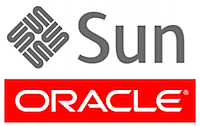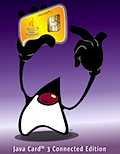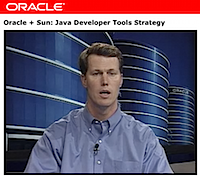You are currently browsing the tag archive for the ‘JavaCard’ tag.
Tag Archive
JavaOne 2010: Takeaways for Mobile & Embedded
10/01/2010 in Mobile & Embedded | Tags: Embedded Java, Java, Java Card, Java ME, Java TV, JavaCard, JavaOne, Mobile Java | 6 comments
Now that JavaOne is done it’s time to reflect on the key takeaways for mobile and embedded.
Both Thomas Kurian as well as Greg Bollella reiterated Oracle’s commitment to modernizing the Java ME platform. Highlights:
- Updates to the CDC and CLDC configurations (project “Java ME.next”)
- Integration of web technologies
- Adding new device APIs to access hardware and operating system features
- Ongoing improvements in performance, footprint, and CPU efficiency
Project “Java ME.next”
A proposal to update the CDC and CLDC configurations has been discussed with the JCP. Key elements:
- Adopt features from JDK 1.6 (language, VM, libraries)
- Improve compatibility between CDC and CLDC
- Extend APIs in new or optional packages, where appropriate
- Maintain backwards compatibility, no business disruption
Integration of Java ME + Web technologies
This aims to bring together Java ME applications and web content to integrate and work more seamlessly together:
- Leverage web content from Java apps (xHTML via LWUIT, HTML via JSR 290/Webkit engine)
- Access device capabilities from JavaScript (via JavaScript engine)
- Integration between Java and JavaScript (via Java/JavaScript bridge)
- Support multiple application models and content types (Java apps, web apps, web widgets)
New Device APIs to access H/W and OS features
Complementing existing APIs with new and enhanced APIs for graphics, near-field communication, IMS, sensors, payment, telephony, location.
Platform improvements
Ongoing improvements in footprints, performance, and CPU efficiency across runtimes for phones, TVs, and Java Cards.
More details on the Java ME roadmap can be found on the OTN Java ME roadmap tab. The complete keynotes and slides can be found on the Oracle on-demand portal.
Cheers,
— Terrence
Oracle+Sun: Java News Round-Up, Part 3
02/04/2010 in Mobile & Embedded | Tags: Developer Community, Java, Java Card, Java ME, Java ME SDK, Java TV, java.net, JavaCard, JavaFX, JavaFX Mobile, JavaOne, Mobile Java, Mobility, NetBeans, Open Source, Oracle, Oracle Technology Network, Sun Microsystems | 1 comment

UPDATES:
- Feb-08: Update on kenai.com
I was tied up in meetings most of the day yesterday so part 3 of the news round-up comes a day late … apologies.
Today, I’d like to summarize the highlights around developer communities and developer engagement under the Oracle+Sun announcements. I am mainly referring to “Overview and Frequently Asked Questions for the Developer Community” published on the Oracle Technology Network (OTN), but I will be including additional information I have collected in the past few days.
Summary points:
- Oracle has a long history of engaging with developers on many levels and this history will continue with respect to Sun’s developer communities
- The Oracle Technology Network (OTN) is one of the industry’s largest developer communities for both Oracle technologies as well as other industry-standard technologies such as Java and Linux. It is similar to the Sun Developer Network (SDN) in that it binds together the technical end-user community as well as Oracle developers and managers.
- OTN features events, news, blogs, articles, wikis, discussions/forums, webcasts, downloads, FAQs, and more across a wide range of technology aspects, including databases, middleware, developer tools, enterprise management, and applications. Specifically for Java, check out the Java Developer Center.
- Many of Sun’s developer sites and communities will remain unchanged in the near future: The Sun Developer Network (SDN), java.sun.com, java.net, BigAdmin, NetBeans.org, and others continue to operate normally. Some may be redesigned and integrated into OTN in the future in communication with the developer community.
- Oracle enthusiastically supports Sun’s user groups such as the Java User Groups (JUGs), OpenSolaris User Groups, Java Champions, and other Sun-related user groups and has already started to reach out to these groups.
- Oracle will also continue the tradition of Java evangelists committed to developer outreach, events, and programs.
- Oracle will continue to invest in the Sun Academic Initiative (SAI) and Java Education and Development Initiative (JEDI) as well as in student communities generally, although the programs may be modified somewhat or migrated over to the Oracle Academy. More details to be provided as they become available.
- Certification programs for Sun technologies: Oracle is committed to provide comprehensive training and certification programs in Sun technologies and will honor exam vouchers purchased through Sun.
JavaOne 2010:
As reported before JavaOne 2010 will be co-located with Oracle OpenWorld in San Francisco in the week of September 19. The call for papers (CFP) will go out shortly.
Sign up for the Oracle Developer Network (OTN):
Your SDN account will not be automatically migrated over to OTN. Sign up for a free account. Also, OTN features a number of regular publications such as the Java-related Dev2Dev Newsletter. Find more information here.
Cheers,
— Terrence
Oracle+Sun: Java News Round-Up, Part 2
02/02/2010 in Mobile & Embedded | Tags: Developer Community, Java, Java ME, Java TV, java.net, JavaCard, JavaFX, JavaFX Mobile, Mobility, NetBeans, Open Source, Oracle, Sun Microsystems, Tools, WTK | Leave a comment
UPDATES:
- Feb-08: Update on kenai.com
This is part 2 of the Oracle+Sun News Round-Up. You can find part 1 here. Part 3 comes tomorrow.
Today I focus on the Oracle’s Java Developer Tools Strategy Webcast with Ted Farrell, Chief Architect and Senior Vice President of Tools and Middleware at Oracle.
Talking points in the webcast:
- Oracle’s motto is “Productivity with Choice”, meaning developers can pick the environment and tools they want – Oracle supports these choices of implementation technologies, development styles, platforms and databases, and IDEs
- Oracle’s main Java development tools today are JDeveloper / Oracle ADF as well as Oracle Enterprise Pack for Eclipse
- NetBeans will be offered as additional choice in the developer tools suite, complementing JDeveloper and Enterprise Pack for Eclipse and leveraging functionality between these tools
- Hudson, Sun’s Continuous Integration Server, will move forward with increased investment and continue to be offered
- Zembly has been discontinued by Sun in Nov 2009
- Kenai is Sun’s hosted collaboration server. Oracle plans to discontinue the public interface of Kenai at this time and bring Kenai back in-house, add features, and leverage it for internal projects. Kenai may be brought back as a public offering later if appropriate.
- NetBeans aims to be the best Java IDE, and will focus on Java and JavaFX technologies for EE, SE, and ME/mobile Java, as well as the NetBeans platform
- Oracle will turn to and invest in the NetBeans community for additional features such as dynamic languages, plug-ins, etc.
- NetBeans.org stays the same – the place for participation, plug-ins, platform, dialog, support, etc.
- No short-term changes planned to NetBeans Partner Programs
- Licensing/support/maintainance: No licenses will change. NB 6.7 and earlier follows Sun support policy. NB 6.8 follows Oracle support policies – better policy with more choices
- New collaboration resource: Oracle Technology Network (OTN), and specifically the Java Technology Center, featuring events, news, blogs, articles, discussions/forums, webcasts, downloads, FAQs, and more
- Events: Oracle OpenWorld/Develop, OTN Developer Days, user group events, and more. See the OTN site.
- JavaOne: Continues as open community event for Java, co-located with Oracle Open World in San Francisco (Sep 19-23, 2010), plus taking JavaOne on the road to Brazil, Russia, India, China
That wraps up Ted’s webcast. Part 3 of the Oracle+Sun: Java News Round-Up follows tomorrow.
Cheers,
— Terrence
Check out Java Card 3.0 Connected Edition: Real Java, just really flat ;-)
11/19/2009 in Mobile & Embedded | Tags: embedded, Java Card, Java ME, JavaCard | 3 comments
 Java Card 3.0 was released a couple of months ago – and the second update (version 3.0.2) is scheduled for December. If you haven’t paid much attention to Java on smart cards because you thought it’s not “real” Java – well, look again.
Java Card 3.0 was released a couple of months ago – and the second update (version 3.0.2) is scheduled for December. If you haven’t paid much attention to Java on smart cards because you thought it’s not “real” Java – well, look again.
It’s true that Java Card 2 was very limited in many ways – a testament to the kind of technology you had available on smart cards 10 years ago. There are billions of these out there today and it is the most popular platform for the GSM SIM and ID market. Java Card 3.0 Classic Edition is a maintenance version of Java Card 2 with some enhancements and bug fixes.
But where Java Card really leaps ahead is with the Java Card 3.0 Connected Edition – it’s the dramatically enhanced next generation of Java Card technology. The Connected Edition contains a new architecture that enables developers to integrate smart cards within IP networks and web services architectures. It supports extended Java Card applets and servlets to allow for these new capabilities in addition to also supporting classic Java Card applets.
Highlights of Java Card 3.0 Connected Edition:
JDK 6 compatible VM
- Supports the latest Java class file version (50) and interoperates with JDK 6 tools
- Key difference: No floating point types
Full Java language support
- Use Java 5 language features like annotations, generics, enhanced for-loops, (un)boxing, and more.
Rich APIs
- GCF, servlet, Java Card 2 API, sockets, threads, transactions ….
Three application models and two library models
- Java Card 3 servlets and classic and extended Java Card applets (not to be confused with Java SE applets)
- Deploy classic or extended libraries
- Create almost any kind of secure application
Servlet Container with Servlet 2.5 support
- HTTP and HTTPS interface
- No need of special client programming – use any web client to reach Java Card 3
Size still measured in KBytes
- Fits in 24K RAM, 128K EEPROM, 512K ROM (running on an embedded 32 bit processor)
Netbeans plug-in for easy development
- See the sneak preview
- New version of plug-in will be available in December with the 3.0.2 release
And … not just cards anymore
- With the newly added USB interface Java Card technology can go way beyond smart cards
- Think secure USB tokens, secure personal databases, embedded servers, WebDAV compliant thumb drives, …
And finally, the Java Card team has started a Kenai project – good info there already, and more being added weekly.
So, check out Java Card 3.0 Connected Edition – Real Java, just really flat 😉
Cheers,
— Terrence
4 New Screencasts: LWUIT, JDTF, JSR 290, and JavaCard
09/04/2009 in Mobile & Embedded | Tags: Java ME, JavaCard, JDTF, JSR 290, LWUIT, Open Source, Sun Microsystems | Leave a comment
Our documentation team has put together four brand-new screencasts on current subjects. They are 5 minutes each in length and a great way to get introduced quickly to the highlights of each topic. I encourage you to have a look:
 LWUIT (Lightweight User Interface Toolkit) screencast
LWUIT (Lightweight User Interface Toolkit) screencast
A 5-minute overview to jump-start your understanding of LWUIT technology — everything you need to know about what it is, why it was created, who should use it, and the functionality it offers.
 JDTF (Java Device Test Framework) screencast
JDTF (Java Device Test Framework) screencast
This brief screen cast introduces JDTF, a flexible, configurable test framework that can be used to assess various aspects of the quality of Java Platform, Micro Edition (Java ME) device implementations.
 JSR 290 (Java Language & XML User Interface Markup Integration) screencast
JSR 290 (Java Language & XML User Interface Markup Integration) screencast
This brief screen cast describes Java Specification Request (JSR) 290, which enables the creation of mobile Java applications that combine Web UI markup with Java code.
This brief screen cast walks you through the highlights of the Java Card Platform, the world’s largest standards-based computing platform.
Enjoy!
Cheers,
— Terrence




Recent Comments